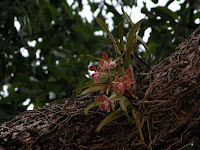
Habenaria marginata

Aerides maculosum

Zeuxine strateumatica









FAMILY OF THE WEEK: ORCHIDACEAE
A large family of 735 genera and over 17000 species, cosmopolitan in distribution but abundant in tropics and rare in arctic regions. This is the second largest family of the Indian flora, with 128 genera and about 881 speciesoccuring in Himalayas western ghats.They are most abundant in eastern Himalayas.
Vegetative characters:
Perennial herbs, terrestrial, epiphytic or saprophytic. The tropical species are mostly epiphytes while those occurring in temperate zones are largely terrestrial.
They have fleshy roots, root stocks corms or bulbs.
Terrestrial forms are sympodial. The internodes are often swollen to store food.
The epiphytic forms are mostly sympodial or sometimes monopodial. They develop aerial roots which have an outer layer of water absorbing tissue, the velamen. Most epiphytic forma drop their leaves in dry season. They usually develop a fleshy pseudo –bulb every year. The saprophytic form don’t have green leaves and they grow on humus.
The leaves are alternate often distichous or rarely opposite. The leaves are often fleshy linear or ovate. They are sheathing at base and encircling the stem.
Inflorescence and flowers:
They are solitary or in racemes spikes or in panicles.
The flowers are often showy and beautifully coloured. They are bracteates, bisexual or rarely unisexual zygomorphic and epigynous. The perianth is in two trimerous whorls, the outer often calyx like and inner corolla like. The tepals are free or variously connate in each whorl. Outer tepals are alike. The two lateral tepals of the inner whorl are alike but the median tepal is very different in size, shape and the colour from the lateral tepals. It is bulbous,spurred,tubular,strap shaped or variously divided and contribute to the beauty of the flower. This modified tepal is called lip or labellum.
The most characteristic pattern of the orchid flower is gynandrium or coloumn which is a highly complex structure formed by the adnation of the stamens style and the stigma.
The androecium is usually represented by one or two sessile anthers.
The gynoecium is tricarpellary and syncarpouswith an inferior ovary.
Fruits and seeds:
The fruit is usually a capsule opening laterally by three to six hygroscopically sensitive valves. The seeds are large in number minute often fusiform and rarely winged.
Pollination and seed dispersal:
The flowers are adpted for insect pollination.The innumerable light seeds are suited to distribution by wind.
Examples:
Cypripedium
Catteleya
Habenaria
Vanda
Cymbidium
Dendrobium
Epidendrum
Orchis
Aeridis
Vanilla planifolia
No comments:
Post a Comment